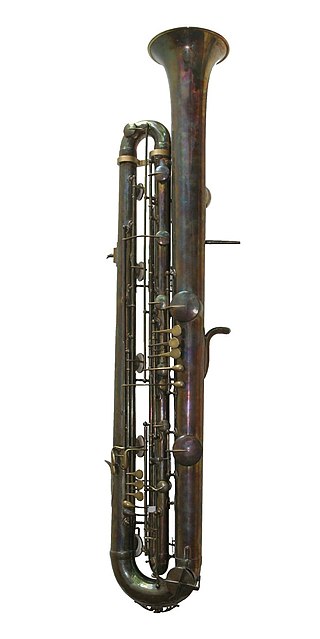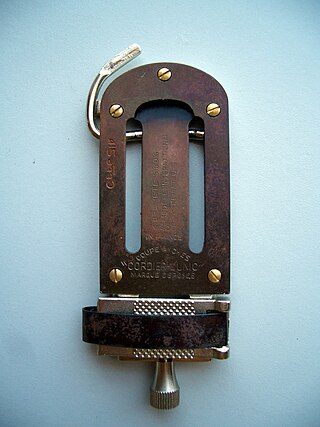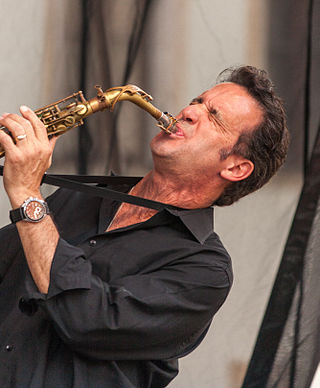
The oboe is a type of double-reed woodwind instrument. Oboes are usually made of wood, but may also be made of synthetic materials, such as plastic, resin, or hybrid composites.

The saxophone is a type of single-reed woodwind instrument with a conical body, usually made of brass. As with all single-reed instruments, sound is produced when a reed on a mouthpiece vibrates to produce a sound wave inside the instrument's body. The pitch is controlled by opening and closing holes in the body to change the effective length of the tube. The holes are closed by leather pads attached to keys operated by the player. Saxophones are made in various sizes and are almost always treated as transposing instruments. A person who plays the saxophone is called a saxophonist or saxist.

Woodwind instruments are a family of musical instruments within the greater category of wind instruments. Common examples include flute, clarinet, oboe, bassoon, and saxophone. There are two main types of woodwind instruments: flutes and reed instruments. The main distinction between these instruments and other wind instruments is the way in which they produce sound. All woodwinds produce sound by splitting the air blown into them on a sharp edge, such as a reed or a fipple. Despite the name, a woodwind may be made of any material, not just wood. Common examples of other materials include brass, silver, cane, and other metals such as gold and platinum. The saxophone, for example, though made of brass, is considered a woodwind because it requires a reed to produce sound. Occasionally, woodwinds are made of earthen materials, especially ocarinas.

A reed is a thin strip of material that vibrates to produce a sound on a musical instrument. Most woodwind instrument reeds are made from Arundo donax or synthetic material. Tuned reeds are made of metal or synthetics. Musical instruments are classified according to the type and number of reeds.

Yamaha Corporation is a Japanese musical instrument and audio equipment manufacturer.

The basset clarinet is member of the clarinet family similar to the usual soprano clarinet but longer and with additional keys to enable playing several additional lower notes. Typically a basset clarinet has keywork going to a low (written) C or B, as opposed to the standard clarinet's E or E♭. The basset clarinet is most commonly a transposing instrument in A, although basset clarinets in C and B♭ and very seldom in G also exist. The similarly named basset horn is also a clarinet with extended lower range, but is in a lower pitch ; the basset horn predates, and undoubtedly inspired, the basset clarinet.

The contrabass clarinet (also pedal clarinet, after the pedals of pipe organs) and contra-alto clarinet are the two largest members of the clarinet family that are in common usage. Modern contrabass clarinets are transposing instruments pitched in B♭, sounding two octaves lower than the common B♭ soprano clarinet and one octave below the bass clarinet. Some contrabass clarinet models have extra keys to extend the range down to low written E♭3, D3 or C3. This gives a tessitura written range, notated in treble clef, of C3 – F6, which sounds B♭0 – E♭4. Some early instruments were pitched in C; Arnold Schoenberg's Fünf Orchesterstücke specifies a contrabass clarinet in A, but there is no evidence such an instrument has ever existed.
Conn-Selmer, Inc. is an American manufacturer of musical instruments for concert bands, marching bands and orchestras. It is a wholly owned subsidiary of Steinway Musical Instruments and was formed in 2003 by combining the Steinway properties, The Selmer Company and United Musical Instruments.

Buffet Crampon SAS is a French manufacturer of wind instruments based in Mantes-la-Ville, Yvelines department. The company is the world market leader in the production of clarinets of the Boehm system. Its subsidiary, Buffet Crampon Deutschland GmbH, founded in 2010 and based in Markneukirchen, Vogtland, Sachsen, is the world market leader in the manufacture of brass instruments. To manufacture and sell its products, the BC Group employed around 1000 people worldwide at the beginning of 2021, 470 of them as employees of BC Germany alone. The management of the group has been in the hands of Jérôme Perrod since 2014.

A single-reed instrument is a woodwind instrument that uses only one reed to produce sound. The very earliest single-reed instruments were documented in ancient Egypt, as well as the Middle East, Greece, and the Roman Empire. The earliest types of single-reed instruments used idioglottal reeds, where the vibrating reed is a tongue cut and shaped on the tube of cane. Much later, single-reed instruments started using heteroglottal reeds, where a reed is cut and separated from the tube of cane and attached to a mouthpiece of some sort. By contrast, in a double reed instrument, there is no mouthpiece; the two parts of the reed vibrate against one another. Reeds are traditionally made of cane and produce sound when air is blown across or through them. The type of instruments that use a single reed are clarinets and saxophone. The timbre of a single and double reed instrument is related to the harmonic series caused by the shape of the corpus. E.g. the clarinet is only including the odd harmonics due to air column modes canceling out the even harmonics. This may be compared to the timbre of a square wave.

The contrabass sarrusophone is the deepest of the family of sarrusophones, built in three sizes pitched in E♭, C or B♭. It was made in the 19th and early 20th centuries, primarily in France by its inventor and Parisian instrument maker Pierre-Louis Gautrot and his successor Couesnon & Co., and Evette & Schaeffer. It was also made in Italy by Milan manufacturers Romeo Orsi and Rampone & Cazzani, and in the United States by C. G. Conn, who built instruments in E♭ for US military bands. Romeo Orsi and the German instrument maker Benedikt Eppelsheim make individual contrabass sarrusophones on request.
Vandoren is a manufacturer of mouthpieces, reeds, and accessories for the clarinet and saxophone families.

The mouthpiece of a woodwind instrument is that part of the instrument which is placed partly in the player's mouth. Single-reed instruments, capped double-reed instruments, and fipple flutes have mouthpieces while exposed double-reed instruments and open flutes do not. The characteristics of a mouthpiece and reed can play a significant role on the sound of the instrument.

A reed clipper is a small tool used by clarinet or saxophone players to adjust the single reeds used on those instruments. The clipper is used to trim off a portion from the tip of the reed, similarly to a nail clipper. This can make a soft reed harder or more resistant, remove imperfections on the tip, or extend its life. Clipped reeds are also believed to produce a darker, warmer sound.
Leblanc, Inc. was a musical instruments manufacturing company based in Kenosha, Wisconsin. The company was a woodwind instrument manufacturer known mainly for its clarinets. In 2004 the firm was sold to Conn-Selmer, a division of Steinway Musical Instruments. As a result, Leblanc ceased to exist as an independent operation, becoming a brand.

Eric Marienthal is a Grammy Award-nominated Los Angeles-based contemporary saxophonist best known for his work in the jazz, jazz fusion, smooth jazz, and pop genres.
Steinway Musical Instruments, Inc. is a worldwide musical instrument manufacturing and marketing conglomerate, based in Astoria, New York, the United States. It was formed in a 1995 merger between the Selmer Industries and Steinway Musical Properties, the parent company of Steinway & Sons piano manufacturers. From 1996 to 2013, Steinway Musical Instruments was traded at the New York Stock Exchange (NYSE) under the abbreviation LVB, for Ludwig van Beethoven. It was acquired by the Paulson & Co. private capital firm in 2013.
Diana Haskell is a multi-faceted clarinetist who works as an orchestral clarinetist, educator, clinician and chamber musician. Haskell is currently Associate Principal Clarinet with the St. Louis Symphony Orchestra. In her role as Associate Principal Clarinet, the St. Louis Post-Dispatch has described her artistry as "perfectly played...with hymn-like beauty". Since 2003 Ms. Haskell has also performed numerous times with the St. Louis Symphony Orchestra as soloist, including with Maestro David Robertson and Maestro Jahja Ling.

Vito is a brand name of Leblanc, started in 1951.

Backun Musical Services Ltd. (BMS) is a Canadian manufacturer of clarinets in B♭ and A and accessories, based in Burnaby, British Columbia.














